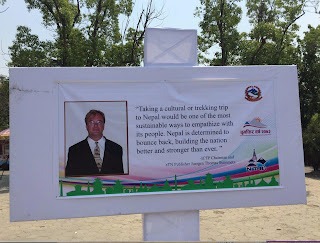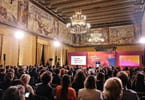It’s hard to understand. A year after the devastating earthquake in Nepal, the travel tourism industry in Nepal is functioning normally. Nepal is telling the world, we’re open and ready for business. More visitors are urgently needed.
eTN Publisher Juergen Thomas Steinmetz told his readers after the earthquake: “Taking a cultural or trekking trip to Nepal would be one of the most sustainable ways to empathize with its people. Nepal is determined to bounce back, building the nation better and stronger than ever.”
This comment is now shown at a memorial park in Kathmandu and it applies even more now.
One year after the devastating earthquake in Nepal, the worst-hit regions are still very far from normality. Reconstruction efforts are slow and people feel abandoned. Stefan Nestler reports from the earthquake zone.
Today tourists can enjoy a fantastic and affordable holiday in Nepal. Unfortunately they don’t see everything when they visit cultural monuments or go mountain climbing, or simply enjoy the peace and quietness of one of the most spectacular scenery on earth.
There is a sad side to Nepal. The mountain country is still a region of tarpaulins, tents and tin-roofed shacks. Tourists are needed, and anyone wanting to help should consider Nepal as a travel destination.
International tour operators have no reason to be discouraged when pushing Nepal.
On the residential page it appears not much rebuilding had happened. In some regions it is as if the country has been frozen in time.
The streets have been cleared of rubble and the most obviously unstable structures have been brought down, but that is where the so-called “reconstruction effort” stopped.
Virtually none of the 800,000 buildings it is reckoned the quake destroyed have been rebuilt.
The lack of progress is most stark in the countryside. Whole villages are still shattered and broken.
According to the Red Cross, four million people are still living in sub-standard temporary shelters.
The victims of the earthquake have received some small payments from the government – for hardship and compensation for the loss of relatives – but it promised it would also give every family that has lost a home money towards the cost of rebuilding. Most of that money has not been paid.
Many say corruption in the government has slowed rebuilding. Fortunately the Nepal Tourism Board is under excellent leadership with dedicated people ready to reach out to the world.
eTN will be sponsoring a U.S. road show in June and is looking for participation from Denver, Phoenix, San Francisco, Seattle, and Vancouver.
Nepal is seen at most major tourism trade shows around the world.
WHAT TO TAKE AWAY FROM THIS ARTICLE:
- A year after the devastating earthquake in Nepal, the travel tourism industry in Nepal is functioning normally.
- Unfortunately they don’t see everything when they visit cultural monuments or go mountain climbing, or simply enjoy the peace and quietness of one of the most spectacular scenery on earth.
- “Taking a cultural or trekking trip to Nepal would be one of the most sustainable ways to empathize with its people.























